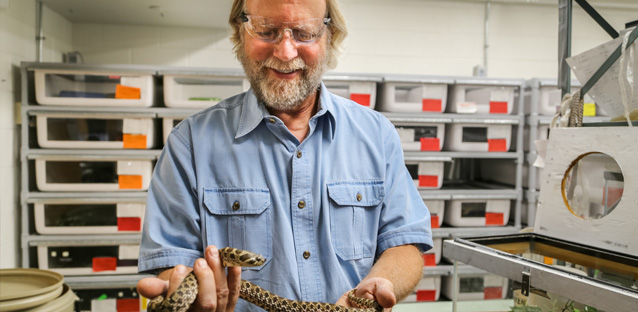- Decoding Toxins in Snake Venom
Professor of Biology Stephen P. Mackessy, Ph.D., (above) worked with colleagues to identify two toxins in the venom of a species of snake that affect prey differently. The toxins, named sulditoxin and sulmotoxin 1 by the UNC researchers, were discovered in the Amazon Puffing Snake as part of Mackessy’s ongoing research exploring the evolution of venoms. Sulditoxin is “highly toxic” toward lizard prey but harmless to mammals, such as rodents. Sulmotoxin 1, on the other hand, is the opposite. “This is the first case in which a bimodal and contrasting pattern of toxicity has been shown for proteins in the venom of a single snake in relation to diet,” the study reported. In addition to venom evolution, Mackessy studies venoms for possible cancer treatment in humans.
- Lerach Studies How Dust Influences Thunderstorms
Associate Professor of Meteorology David Lerach, Ph.D., studies how dust — specifically dust from the Chihuahuan Desert in the Southwestern U.S. — potentially influenced an outbreak of tornadic thunderstorms in Texas. His research was published in July. In the computer-simulated storms outbreak, Lerach found that dust particles blown into the air absorbed sunlight and limited the ground’s ability to heat up during the day, thus producing a weaker line of thunderstorms characterized by weaker updrafts and less precipitation. Lerach’s future research will focus more on idealized thunderstorm scenarios in an attempt to isolate the atmospheric environments that are most and least susceptible to the influence of dust on storm severity using the model.
- Studying Investments for Watersheds
By 2060, around two-thirds of the world’s population will live in cities and will need sustainable drinking water. Environmental and Sustainability Studies Assistant Professor Chelsie Romulo, Ph.D., worked with her team to comb through data from The Nature Conservancy on investments made by cities to fund watershed services. For example, cities might invest in services that keep ecosystems in rural areas healthy in order to ensure clean drinking water in urban areas. They reported back to The Nature Conservancy on their findings in order to help the organization prioritize programs and recently published a paper on their research in the journal Nature Communications.
“This paper was the culmination of a very large interdisciplinary project,” Romulo says. “The idea being that if people who are drinking water in a city want to have clean water, then the best thing to do would be to actually pay for the people living in watersheds to do things that maintain a clean watershed.”


